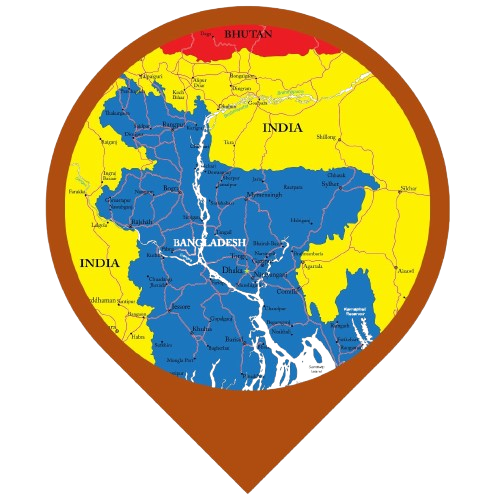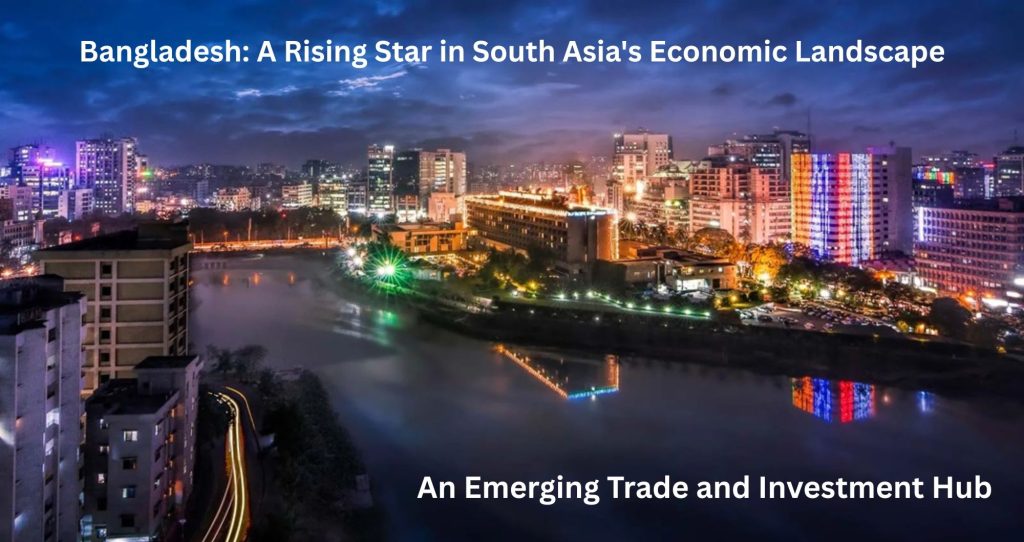A Rising Star in South Asia's Economic Landscape
Bangladesh: An Emerging Trade and Investment Hub in South Asia
Bangladesh, a rapidly developing economy in South Asia, has gained international recognition as a rising economic power. Situated at the crossroads of South and Southeast Asia, Bangladesh’s geographical position, population advantage, industrial growth, and business-friendly legal and financial structure make it an attractive destination for both local and foreign investors.

🌍 Geographical Location & Connectivity
Bangladesh lies between latitudes 20°34′N and 26°38′N and longitudes 88°01′E and 92°41′E. Sharing borders with India on three sides, Myanmar to the southeast, and the Bay of Bengal to the south, the country is strategically located as a gateway to South and Southeast Asia. This position gives it a unique advantage for regional connectivity, cross-border trade, and transshipment.
Total area: 147,570 sq. km
Coastline: 580 km (with deep seaports at Chattogram, Payra, and Mongla)
Major international airports: Dhaka, Chattogram, and Sylhet
 Demographics & Human Capital
Demographics & Human Capital
As of mid-2024, Bangladesh’s estimated population is over 171 million, making it the eighth most populous country in the world. With a median age of 27.6 years, Bangladesh boasts a youthful and productive workforce.
-
Labor force participation rate: 58.6%
-
Literacy rate: 76.8% (2023, age 15+)
-
Urban population growth: 3.3% annually (2020–2023)
-
Remittance inflow: USD 21.6 billion (FY 2023)
This large, low-cost, and trainable workforce provides a competitive edge for labor-intensive industries like textiles, ITES, and manufacturing.


🏭 Industrial Landscape & Export Power
Bangladesh’s industrial sector has diversified beyond garments into pharmaceuticals, IT, ceramics, jute, shipbuilding, and agro-processing.
GDP (Nominal): USD 460.8 billion (2023–2024)
Export earnings: USD 65 billion (FY 2023–2024)
RMG sector share: Over 81% of total exports (USD 55 billion in FY 2023)
ICT Export: USD 1.9 billion (FY 2023), with target to reach USD 5 billion by 2025
Bangladesh ranks among the top 3 global apparel exporters, after China and Vietnam.
🌐 Trade & Investment Opportunities
Bangladesh offers a liberal trade regime, competitive export incentives, and FTAs with various countries.
Key Trade Facts:
Duty-free/quota-free access to EU, UK, Canada, Japan, Australia under EBA/GSP
Active participation in SAFTA, BIMSTEC, and WTO
100+ economic zones planned by 2030, with 12 operational EZs already in place
Major Import Partners:
China, India, Singapore, UAE, Malaysia
Major Export Partners:
USA, Germany, UK, Spain, Canada


📜 Legal & Regulatory Framework
Bangladesh has reformed business laws to support FDI and ease of doing business.
Key Legal Highlights:
Companies Act (Amended 2020) allows One Person Company (OPC)
FDI up to 100% allowed in most sectors
Intellectual Property Rights (IPR) protected under international treaties
No local partner required for foreign company registration
Business Setup in Bangladesh Requires:
Name Clearance (RJSC)
Trade License
TIN and BIN Registration
VAT Registration
BIDA registration (for foreign entities)
💰 Financial Structure & Banking Ecosystem
Bangladesh has a robust banking and financial sector regulated by the Bangladesh Bank, comprising:
61 scheduled banks (private, state-owned, and foreign)
34 non-bank financial institutions (NBFIs)
Digital banking services are rapidly expanding
Currency: Bangladeshi Taka (BDT)
Exchange Rate (June 2024): 1 USD ≈ BDT 118
Inflation rate: 9.3% (2023)
Interest rate: ~9.5% (commercial loans)
Corporate tax rates: 20% to 30% depending on the sector


📈 Fiscal & Non-Fiscal Incentives
Bangladesh offers a compelling suite of incentives:
Tax holidays (5–10 years) for specific sectors
Accelerated depreciation, export subsidies, and cash incentives
Repatriation of capital and profits fully allowed
Visa and work permit facilitation via BIDA
🚀 Bangladesh’s Growth Outlook
Bangladesh’s economy is projected to grow at 6.5–7.0% annually, with massive infrastructure projects under implementation:
Padma Bridge: Estimated to add 1.2% to GDP
Dhaka Metro Rail & Elevated Expressway
Smart Bangladesh Vision 2041

📌 Conclusion
Bangladesh is no longer just a ready-made garments (RMG) story — it’s a full-fledged investment destination with growing digital, industrial, and services sectors. Its demographic dividend, favorable geo-economic location, legal reform, and industrial transformation position it as one of the most promising economies in Asia.
Now is the time for global investors to take Bangladesh seriously — the gateway to a market of 2 billion+ people in South and Southeast Asia.

